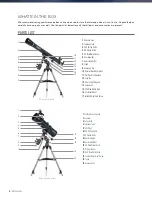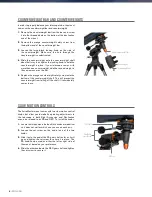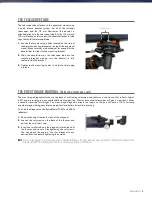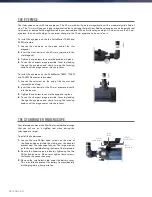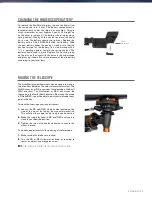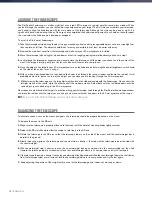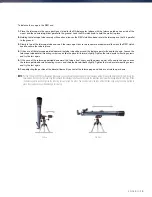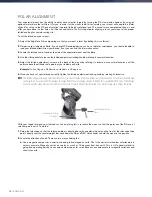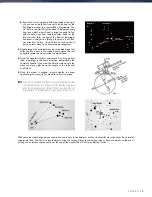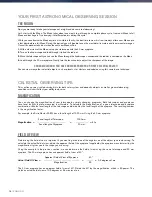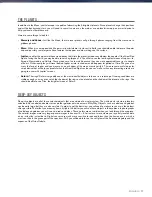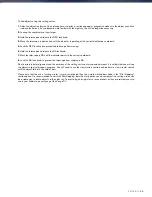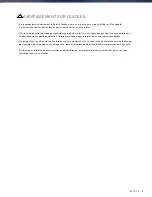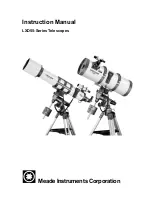
20
I
ENGLISH
DEEP-SKY OBSERVING EQUIPMENT
There are some tools that will be indispensable to you for identifying and locating deep-sky objects:
•
Red Flashlight- This is an essential tool for deep-sky astronomy for reading finder charts or star atlases In order to see
the faint light coming from distant objects like nebulae or galaxies, your eyes must be fully dark adapted with your irises
open to the fullest extent to let the most light from your telescope into them White light from a standard flashlight will
causes your eye’s irises to close down and it can take up to a half-hour for your eyes to return to full dark adaptation Red
lights do not have the same effect We recommend any red LED flashlight that has adjustable brightness output, because
even red light, if excessively bright can affect your night vision These are available through most telescope retailers but
can also be found in camping and hardware stores
•
Planisphere- A planisphere is a special circular star map that will show you the rough placement of constellations over
your head, so you can navigate your way across the sky Unlike charts you can print online, planispheres are good for
any time of year, not just the date or month you printed it for The planisphere consists of two round disks joined at the
center The bottom disk has a map of the constellations while the top disk has a window cut into it out showing a portion
of the sky map By turning the inner and outer disks to match your specific date and time, the map will display only those
constellations visible to you at that time This is handy for finding rough locations of bright stars and constellations
Planispheres are available through book stores and are available for a number of geographical latitudes in the Northern or
Southern Hemispheres Be sure to pick one that is designed for your location To get more detailed information on where
deep-sky objects reside within constellations you will need a Star Atlas
•
Star Atlas- Star atlases are the roadmaps of the sky Once you have located a constellation with your planisphere, the
Star Atlas will show you a detailed, close-up view of that region of sky showing the stars and deep-sky objects that reside
in it These are available through many telescope retailers or bookstores
•
Apps and Programs- There are many applications available for a smartphone or tablet that can take the place of the
planisphere and star maps These will give digital representations of the night sky on your device, allowing you to go from
a wide view to a zoomed-in view with a touch of the screen These can be downloaded or purchased from your application
store, depending on your platform There are also some great astronomical sky simulation programs available for your
computer that will show you very detailed star maps on screen and can help you plan an observing session before you
get outside with printable star maps customized for your date, location and time
STAR HOPPING
The easiest way to find your way around the sky is by a technique called star hopping The first thing you will need to do is
measure the field of view of your finderscope Look in the sky and locate a constellation with bright stars You can use your
planisphere or astronomy app to help identify it Now find the map in your star atlas that shows this constellation Center your
finderscope on any bright star that you can recognize on the star map Hold your head 12 inches behind the reflective window
of your StarPointer finderscope and move the telescope so that the bright star is at the edge of the field if view of the window
(it does not matter which direction you pick) Without moving the telescope, look through the finderscope window and locate
another star near the opposite edge of the field of view Locate this second star on the chart Measure the distance between
these two stars on the chart using a ruler This distance is represents one finderscope field of view on your atlas You can now
use this measurement to locate celestial objects
Summary of Contents for ASTROMASTER EQ
Page 2: ......
Page 4: ...4 I ENGLISH ...
Page 26: ...26 I ENGLISH NOTES ...
Page 27: ...ENGLISH I 27 NOTES ...
Page 30: ......
Page 32: ...4 I FRANÇAIS ...
Page 54: ...26 I FRANÇAIS NOTES ...
Page 55: ...FRANÇAIS I 27 NOTES ...
Page 58: ......
Page 60: ...4 I DEUTSCH ...
Page 82: ...26 I DEUTSCH HINWEISE ...
Page 83: ...DEUTSCH I 27 HINWEISE ...
Page 86: ......
Page 88: ...4 I ESPAÑOL ...
Page 110: ...26 I ESPAÑOL NOTAS ...
Page 111: ...ESPAÑOL I 27 NOTAS ...
Page 114: ......
Page 116: ...4 I ITALIANO ...
Page 138: ...26 I ITALIANO NOTE ...
Page 139: ...ITALIANO I 27 NOTE ...

